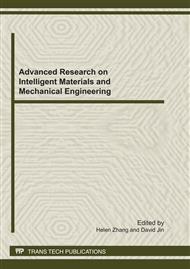[1]
Y. Cai, X. Lu, and Q. Lin, Hollow Gaussian beams and their propagation properties, Opt. Lett. 28, 2003, pp.1084-1086.
DOI: 10.1364/ol.28.001084
Google Scholar
[2]
Y. Cai and L. Zhang, Propagation of a hollow Gaussian beam through a paraxial misaligned optical system, Opt. Commun. 265, 2006, pp.607-615.
DOI: 10.1016/j.optcom.2006.03.070
Google Scholar
[3]
G. Zhou, Propagation properties of a non-paraxial hollow Gaussian beam, Opt. Laser Technol. 41, 2009, pp.562-569.
DOI: 10.1016/j.optlastec.2008.10.011
Google Scholar
[4]
D. Deng, Generalized M2 factor of hollow Gaussian beams through a hard-edge circular aperture, Phys. Lett. A. 341, 2005, pp.352-356.
DOI: 10.1016/j.physleta.2005.04.081
Google Scholar
[5]
Y. Cai and S. He, Propagation of hollow Gaussian beams through apertured paraxial optical systems, J. Opt. Soc. Am. A, 23, 2006, pp.1410-1418.
DOI: 10.1364/josaa.23.001410
Google Scholar
[6]
G. Zhou, X. Chu, and J. Zheng, Investigation in hollow Gaussian beam from vectorial structure, Opt. Commun. 281, 2008, pp.5653-5658.
DOI: 10.1016/j.optcom.2008.08.028
Google Scholar
[7]
Y. Yuan, Y. Cai, J. Qu, H. T. Eyyuboğlu, Y. Baykal, and O. Korotkova, M2-factor of coherent and partially coherent dark hollow beams propagating in turbulent atmosphere, Opt. Express 17, 2009, pp.17344-17356.
DOI: 10.1364/oe.17.017344
Google Scholar
[8]
Y. Ai, Y. Dan and T. Jiang, propagation properties of partially coherent hollow Gaussian beams in atmospheric turbulence, Proc. SOPO, 2011, 5780521.
DOI: 10.1109/sopo.2011.5780521
Google Scholar
[9]
L. Zhang, X. Lu, X. Chen, and S. He, Generation of a Dark Hollow Beam inside a Cavity, Chin. Phys. Lett. 21, 2004, p.298–301.
Google Scholar
[10]
Y. Cai and Q. Lin, Hollow elliptical Gaussian Beam and its propagation through aligned and misaligned paraxial optical systems, J. Opt. Soc. Am. A, 21, 2004, pp.1058-1065.
DOI: 10.1364/josaa.21.001058
Google Scholar
[11]
P. Liu and B. Lü, Phase singularities of the transverse field component of high numerical aperture dark-hollow Gaussian beams in the focal region, Opt. Commun. 272, 2007, pp.1-8.
DOI: 10.1016/j.optcom.2006.11.004
Google Scholar
[12]
Y. Cai, C. Chen, and F. Wang, Modified hollow Gaussian beam and its paraxial propagation, , Opt. Commun. 278, 2007, pp.34-41.
DOI: 10.1016/j.optcom.2007.06.012
Google Scholar
[13]
C. Zhao, X. Lu, L. Wang, and H. Chen, Hollow elliptical Gaussian beams generated by a triangular prism, Opt. Laser Technol., 40, 2008, p.575–580.
DOI: 10.1016/j.optlastec.2007.08.005
Google Scholar
[14]
Y. Dan, S. Zeng, B. Hao, and B. Zhang, Range of turbulence-independent propagation and Rayleigh range of partially coherent beams in atmospheric turbulence, J. Opt. Soc. Am. A, 27, 2010, pp.426-434.
DOI: 10.1364/josaa.27.000426
Google Scholar
[15]
Y. Dan and B. Zhang, Second moments of partially coherent beams in atmospheric turbulence, Opt. Lett. 34, 2009, pp.563-565.
DOI: 10.1364/ol.34.000563
Google Scholar
[16]
A. E. Siegman, New developments in laser resonators, Proc. SPIE. 1224, 1990, pp.2-14.
Google Scholar
[17]
L. C. Andrews, R.L. Phillips, Laser Beam Propagation through Random Media, second ed., SPIE, Bellingham, (2005).
Google Scholar


